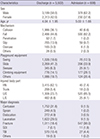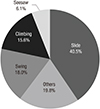1. Mack MG, Hudson S, Thompson D. A descriptive analysis of children’s playground injuries in the United States 1990-4. Inj Prev. 1997; 3:100–103.
2. Tinsworth DK, McDonald JE. Special Study: Injuries and Deaths Associated with Children’s Playground Equipment. Washington, D.C.: U.S. Consumer Product Safety Commission;2001.
3. Vollman D, Witsaman R, Comstock RD, Smith GA. Epidemiology of playground equipment-related injuries to children in the United States, 1996-2005. Clin Pediatr (Phila). 2009; 48:66–71.
4. Schwebel DC, Brezausek CM. Child development and pediatric sport and recreational injuries by age. J Athl Train. 2014; 49:780–785.
5. Song HD, Kim KH, Kim AJ, Park JS, Shin DW, Roh JY, Lee KM. A preliminary study of an emergency department-based in-depth injury surveillance system of preschool children injury. J Korean Soc Emerg Med. 2009; 20:649–657.
6. Mott A, Evans R, Rolfe K, Potter D, Kemp KW, Sibert JR. Patterns of injuries to children on public playgrounds. Arch Dis Child. 1994; 71:328–330.
7. Loder RT. The demographics of playground equipment injuries in children. J Pediatr Surg. 2008; 43:691–699.
8. Lam KY, Sumanth Kumar G, Mahadev A. Severity of playground-related fractures: more than just playground factors? J Pediatr Orthop. 2013; 33:221–226.
9. Schwebel DC, Summerlin AL, Bounds ML, Morrongiello BA. The Stamp-in-Safety program: a behavioral intervention to reduce behaviors that can lead to unintentional playground injury in a preschool setting. J Pediatr Psychol. 2006; 31:152–162.
10. Brussoni M, Gibbons R, Gray C, Ishikawa T, Sandseter EB, Bienenstock A, Chabot G, Fuselli P, Herrington S, Janssen I, et al. What is the relationship between risky outdoor play and health in children? A systematic review. Int J Environ Res Public Health. 2015; 12:6423–6454.
11. Burrows P, Trefan L, Houston R, Hughes J, Pearson G, Edwards RJ, Hyde P, Maconochie I, Parslow RC, Kemp AM. Head injury from falls in children younger than 6 years of age. Arch Dis Child. 2015; 100:1032–1037.
12. Thomas AG, Hegde SV, Dineen RA, Jaspan T. Patterns of accidental craniocerebral injury occurring in early childhood. Arch Dis Child. 2013; 98:787–792.
13. Joeris A, Lutz N, Wicki B, Slongo T, Audigé L. An epidemiological evaluation of pediatric long bone fractures - a retrospective cohort study of 2716 patients from two Swiss tertiary pediatric hospitals. BMC Pediatr. 2014; 14:314.
14. Chan V, Thurairajah P, Colantonio A. Defining pediatric traumatic brain injury using International Classification of Diseases Version 10 Codes: a systematic review. BMC Neurol. 2015; 15:7.
15. Ghajar J. Traumatic brain injury. Lancet. 2000; 356:923–929.
16. Ministry of Public Safety and Security (KR). The facility and technical standards of play equipment for children [Internet]. accessed on 15 March 2016. Available at
http://www.cpf.go.kr/front/index.do.
17. Sherker S, Ozanne-Smith J. Are current playground safety standards adequate for preventing arm fractures? Med J Aust. 2004; 180:562–565.
18. Sherker S, Ozanne-Smith J, Rechnitzer G, Grzebieta R. Out on a limb: risk factors for arm fracture in playground equipment falls. Inj Prev. 2005; 11:120–124.
19. Mathison DJ, Agrawal D. An update on the epidemiology of pediatric fractures. Pediatr Emerg Care. 2010; 26:594–603.
20. Macarthur C, Hu X, Wesson DE, Parkin PC. Risk factors for severe injuries associated with falls from playground equipment. Accid Anal Prev. 2000; 32:377–382.
21. Howard AW, Macarthur C, Rothman L, Willan A, Macpherson AK. School playground surfacing and arm fractures in children: a cluster randomized trial comparing sand to wood chip surfaces. PLoS Med. 2009; 6:e1000195.
22. Sosin DM, Keller P, Sacks JJ, Kresnow M, van Dyck PC. Surface-specific fall injury rates on Utah school playgrounds. Am J Public Health. 1993; 83:733–735.
23. Laforest S, Robitaille Y, Lesage D, Dorval D. Surface characteristics, equipment height, and the occurrence and severity of playground injuries. Inj Prev. 2001; 7:35–40.









 PDF
PDF ePub
ePub Citation
Citation Print
Print








 XML Download
XML Download